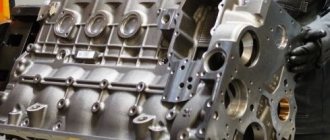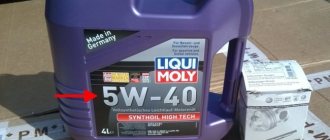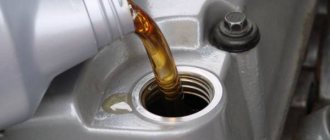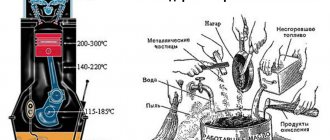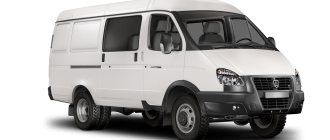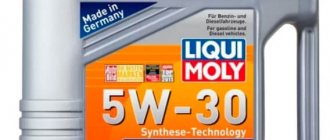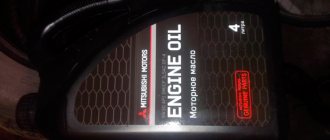When to change the oil
The recommended oil change interval for the ZMZ-405 engine is 10 thousand km or every 12 months, depending on how quickly the lubricant deteriorates. This can be understood by its condition, which should be checked regularly, especially during frequent city trips. Such conditions are characterized by sharp starts and braking, frequent gear changes, active maneuvers and lane changes. Active and dynamic driving also negatively affects the life of useful oil additives, which, when damaged, are not able to properly cool and lubricate the internal combustion engine parts, resulting in the need to change the oil earlier than the specified period.
How to change gearbox oil in a gazelle car, how much is included and which one to choose?
Hi all. The topic of today's article is oil in the gearbox of a gazelle car, how much to fill, how to change it and what oil to choose?
It so happened that the gazelle received a highly modernized box from a Volga car. It is important to understand that the Volga is a passenger car, and the Gazelle is a truck, which often works with overload and the gearbox is a consumable item. At least somehow extending the life of the box will help to use high-quality oil and adherence to its replacement interval.
How to change the oil in the gearbox of a Gazelle car?
We need a tool:
Hexagon 12 - we will use it to unscrew and tighten the drain plugs
Basin - we will drain used oil into it
Syringe - we will use it to fill in the oil, but if you wish, you can do without it.
Oil change procedure:
- We drive 10-20 km so that the oil in the box warms up and becomes more liquid.
- We drive into a pit or lift (or simply crawl under the frame as the height of the body allows)
- Unscrew the drain plug and substitute the basin
- We are waiting for the oil to stop draining
- We wipe the magnet of the drain plug from shavings and wrap it back.
- We unscrew the filler plug and fill in the oil with a syringe until it runs out of the filler plug.
- We wipe the threads and tighten the filler plug.
All the oil in the box has been changed and you can drive =)
If you do not have a syringe, you can pour oil into the box through the gear shift lever. To do this, remove the rubber cover and unscrew the lever itself (done by hand without tools, by hand).
Pour the oil directly into the box. Accordingly, fill in the oil until it comes out of the filler plug.
I warn you against filling the oil “according to the norm” (1.2 liters)! The fact is that the castings of the boxes are slightly different and what is normal for one box will not be enough for another! Remember, a low level is bad because the insides of the box will quickly wear out, and a high level is bad because the seals will start to sweat oil! Fill with oil until it comes out of the filler neck!
If you cannot unscrew the filler plug, try the plug on the other side (the exhaust pipe may be in the way). It’s strange, but true, there are 2 filler plugs on the gearboxes of gazelles and Volgas, this is due to the fact that the cars were equipped with different engines in different years and their exhaust pipes were on different sides.
Oil change interval in the gearbox of a gazelle car.
The factory recommends an oil change interval of 50,000 km, but in practice, in a gazelle box it is better to change it twice as often, i.e. every 3 engine oil changes or 30,000 km. Unless genuine synthetic motor oils can be changed less frequently.
GAZ Sobol 2005 - scheduled maintenance
Comments26
Participate in the discussion can only registered users.
Gazprom pour 10/40 semi-blue... replace every 10 tons
Thank you, but I won’t pour Russian oil!
By the way, Gazprom shows very good results in tests, better than some imported ones. It’s better to take ours than an imported counterfeit from waste
You know better, but on principle I won’t take Russian butter! I have normal stores where there are no fakes!
A strange statement, living in Russia, driving a Russian car and categorically denying Russian oil,
liquid-moly molybdenum...on the classic, the engine went 200,000 km, and now on the ZMZ40522, the mileage is 140,000 km. and the engine is clean. I didn't do anything to the engine. I don't see much difference in filters. The main thing is that there is a large filter element. The Balakovo belt was worn out at 70,000 and was replaced because it was cracked inside. all the others go 15-20k km. decide youself . Now there is just a large selection.
Thank you! I'm also looking at liquid moly molybdenum.
ELF EVOLUTION 900 NF 5W40.SINT 160000tkm normal flight
I pour Eurol 5w-40 synthetic. price-quality ratio. NGK spark plugs
Lil Castrol... I've just switched to Mobile 1 10w60, which only makes me happy with the special oil for engines with over a hundred mileage... NGK spark plugs, Ruben belt, Kolan filter.
Take simple A14DVRM candles that the Bosch group makes, they cost a penny - they work great. Don’t even bother with any imported ones.
LeshiyS
Take simple A14DVRM candles that the Bosch group makes, they cost a penny - they work great. Don’t even bother with any imported ones.
for our A17 it’s not 14
For winter, 14 is better, they are “hotter”. In summer you can have 17. In fact, 14 runs fine in both winter and summer.
Lew Total quartz synthetic 5w40 filter mann. I used to be a fan of Shell, but now it seems to me that it’s better to pour Lukoil. The belt for me in Car Pedals was advertised as ours, Balakovsky, but I don’t have enough statistics on it, it has only lasted 500 km since replacement.
zik is very rarely counterfeited. especially in cans
There have been plenty of fakes for a long time now.
Yes? And here everyone is talking about Castrol. Like completely fakes.
it is truth too . the real thing is hard to find right now. two neighbors killed their engines on a Zika... it turned out to be a fake...
All comments
Advantages and disadvantages of the engine
Before we talk about changing the oil in a Gazelle engine, it’s worth finding out how good or bad this engine is. This way you will better understand in which modification it is better to purchase a car.
The strengths of the 405 family include:
- the presence of a modified cylinder head using a two-layer metal gasket, supplemented with spring components;
- the total weight of the cylinder block has decreased by 1.35 kilograms compared to its predecessor;
- A catalytic three-component type of converter is used, which allows it to comply with Euro 3 requirements;
- due to modifications, highway consumption decreased to 8.8 liters per 100 kilometers;
- An oil purification system is used.
Some consider the fact of using a microprocessor to control the ignition timing an advantage, while others call it a disadvantage. The system works better and more efficiently, but it is impossible to repair this unit in highway conditions when the car is stuck.
At the same time, hydraulic compensation of the thermal gap in the valves led to a reduction in the cost of maintaining the Gazelle. So, you no longer need to visit a car service center to adjust the valves, as happened before.
This is frankly a good engine that is perfect for the Gazelle car. From its technical characteristics we highlight the following:
- compression ratio is 9.4;
- working volume 2.4 liters;
- torque reaches 211 Nm;
- the engine produces 152 horsepower.
With such an engine, Gazelle feels confident in the city and on the highway. If you use suitable and appropriate ones, it will be possible to minimize engine contamination, reduce friction between contacting surfaces and extend the life of the power unit.
Design Features
Initially, the ZMZ 405 engine included the following promising technical solutions for 2000:
- distributed injection inside the cylinder head channels;
- in-line engine diagram with two timing shafts for 4 valves in each cylinder;
- closed ventilation circuit with vacuum inside the crankcase;
- updated attachments in the form of a two-valve thermostat, a thermoresistive coolant sensor, an induction synchronizer, a Hall sensor and a magnetoresistive throttle module;
Cylinder block design
Cylinder head ZMZ 405
Forged connecting rods, steel-aluminum crankshaft bearing shells, rubber-coated damper pulley to dampen harmful vibrations.
Oil selection
There is no fundamental difference between pouring domestic and imported motor oil into Gazelle 405 engines. Many people believe that foreign lubricants are of higher quality and are significantly ahead of their domestic counterparts in this component.
This is not entirely true. It all depends on the manufacturer. Among imported oils there are truly high-quality solutions with excellent properties and characteristics. And there are also low-grade compounds, pouring which into the Gazelle engine will only harm the engine.
There are two main criteria here:
- domestic service station classification, in this case the selected oil must meet the requirements of B4/D2;
- The international API classification is relevant for imported oils.
According to API, the following oils are suitable for Gazelle 405:
- SL/SM;
- SJ/CD;
- SJ/SH/CF.
If you find a motor lubricant that meets these requirements, you're already half done.
It is also important that the oil for the Gazelle meets the temperature conditions in which the car is operated. Most adhere to the principle of choosing all-season oils. Only for certain regions of the country, where the temperature drops below -30 degrees Celsius, it is necessary to use purely winter brands of motor oils.
The most common viscosity solutions for Gazelle 405 are:
In the first case, the oil can withstand operation in the temperature range from -30 to +20 degrees Celsius. This is acceptable for some regions of Russia.
But 0W40 is considered more universal. This composition does not lose its properties and fluidity in the temperature range from -30 to +35 degrees Celsius.
Taking into account the climatic characteristics of your region, in terms of viscosity indicators you can use the following oils for Gazelle 405:
- 0W30;
- 5W30;
- 5W40;
- 10W40;
If the required amount of engine oil is poured in a timely manner, and you use high-quality compounds, then you will not face problems with premature engine wear.
If we talk specifically about which oil is best to fill in the Gazelle 405 by manufacturer, then the most popular brands here are:
But under no circumstances should you use oils from different manufacturers when replacing. When changing the lubricant in the engine yourself, which does not involve flushing the system, only fill in exactly the same composition.
If you switch to an alternative brand, even if the characteristics between lubricants are completely consistent, you must flush the engine crankcase. This is done with special flushing fluids or oils.
What kind of oil should I put in Gazelle?
“What kind of oil should I put in a Gazelle?” ask motorists, appreciating the advantages of these spacious and maneuverable vehicles. So, indeed, the Gazelle brand car has become firmly established in our lives. They combine convenience and unpretentiousness. Good carrying capacity, dimensions, affordable price, minimal maintenance costs - all this suits both drivers and passengers. The Gazelle car has several modifications, ranging from a regular truck to a spacious luxury minibus. Like any car, the Gazelle needs regular maintenance, especially the replacement of consumables. Our article will discuss changing oil and other technical fluids in a Gazelle car.
What engine oil is best to pour into the Gazelle engine in the summer Next?
When considering this modification of the car, you need to know which engine oil is best to fill in the Gazelle engine in the summer Next? GAZelle NEXT was designed by Russian engineers taking into account the requirements of millions of consumers. This vehicle is used in various activities. It provides solutions to a wide range of transport problems at minimal cost. Changing the oil in the GAZelle NEXT engine is a mandatory procedure that must be performed strictly according to the regulations. The manufacturer recommends changing the oil in Gazelle engines every 10-15,000 kilometers. Regardless of whether the engine is gasoline or diesel, 10 liters of oil are required to change it.
Gazelle owners prefer oil with a viscosity grade of 10W40, which can be used both in summer and winter.
We offer a list of the most popular oils that are usually filled into Gazelle, including GAZelle NEXT:
- OIL LUX 10w-40;
- Shel helix 10/40;
- Mobil Delvac;
- Nissan 10W40;
- Magnum 10W40;
- Mannol.
What oil is better to fill in an automatic transmission (automatic transmission) Gazelle Cummins?
The Cummins diesel engine is known for its universal use, but which oil is better to fill in the automatic transmission (automatic transmission) of the Gazelle Cummins? Not only its efficiency, but also the reliability of the engagement of the engine and transmission depends on the condition of the car’s gearbox. It is recommended to change the gearbox oil every 60,000 kilometers. In this case, it is necessary to regularly check the transmission fluid level (every 20,000 kilometers). 1.2 liters of oil is poured into the gearbox. It is recommended to use SAE 75W-85 or 75W-90 oil.
What kind of oil is poured into the mechanics at the factory (officials) in winter for Gazelle Business?
A car owner who cares about the technical condition of his vehicle needs to know what kind of oil is poured into the mechanics at the factory (officials) in winter for Gazelle Business? For the Gazelle Business manual transmission, oil with a viscosity of 75W90, 80W90 or 75w-140 is suitable. This could be transmission fluid Liqui Moly GL5 75w90, castrol syntrax longlife 75w-140, ipoid 80W90, TNK 75W90 or Shell.
It is recommended to change the oil every 50-60,000 kilometers. To implement this, you will need about two liters of liquid.
How much oil to fill
Year of manufacture since 2000
In technical terms, the ZMZ-405 is almost no different from the 406 engine. Changes were made in the area of increasing the piston diameter to 92 mm (previously it was 95.5 mm). In addition, the ZMZ-405 has thinner inter-cylinder jumpers installed, and slots for cooling have also appeared, but engines with adaptation to Euro-3 do not have them. At the same time, the height of the cylinder block is identical to ZMZ-406. The increase in volume made it possible to increase power by 7 hp. s., at the same time the torque also increased. Otherwise, this is the same 406, despite compliance with Euro-3. The main engine of the family of the same name is the ZMZ-4052.10, known from Volgas and Gazelles. The option with the index 4052.10 corresponds to Euro-2, and 40524.10 – Euro-3. The latter was installed only on the Volga. The more modern 40525.10, which is an analogue of 40522.10, also met Euro 3 and was relevant only for Gazelles. And finally, the ZMZ-4054.10 is the only turbocharged version of the ZMZ-405. It has a steel crankshaft, a forged piston, an intercooler and produces 195 hp. With. This engine was not in demand due to its high cost, so tuners often preferred the proven Toyota 1JZ/2JZ instead.
Gasoline engines 1999-2002
ZMZ 405, 2.4 (152 hp), oil volume - 6 liters, tolerance and viscosity: API-SJ; SAE 5W-40, 10W-40, 10W-30, 5W-30, 0W-30, 0W-40
Volga/Gazelle ZMZ-405 engine tuning
Boosting ZMZ 405.Turbine.Compressor
Options for increasing the power of the ZMZ-405 are no different from the ZMZ-406, you can read about them in the “Tuning” tab here. It is worth noting that it is not worth building powerful naturally aspirated engines on a Volgov/Gazelle engine, on evil camshafts, 4 throttles, it is a waste of money and time. The most correct tuning for ZMZ is turbo. A well-assembled turbo 405 will give more (and sometimes much more) 300 hp, which an aspirated engine will not produce under any settings. It is worth noting that a Euro-2 block is not suitable for the construction of a turbo cramp, it is weakened by the slots between the cylinders, your choice is more recent blocks for Euro-3 (40524.10 and 40525.10).
The topic of the article is ZMZ engine oil. On Yandex there are several thousand requests for this subject per month. And how hotly passions boil on the forums, it’s actually a bullfight)). There are supporters of semi-synthetics, there are adherents of synthetics, there are crusaders who defend the good old mineral water to the last drop of reason. Everyone has their own truth. I will try to summarize my knowledge and operating experience in this topic, in relation to THIS family of engines.
What oil should be used for ZMZ 405
Original
For the ZMZ 405 engine, semi-synthetic motor oil is recommended. The viscosity of the lubricant depends on the operating conditions. For example, 10W-40, 10W-40 or 5W-40 are suitable for all-season use. When used in summer, 20W-40 or 25W-50 is recommended, and mainly in winter, 0W-30, 0W-40 or 5W-30 is used.
Unoriginal
For the ZMZ-405 engine, it is recommended to use proven motor oil from a reputable manufacturer. Among the most famous brands are Kixx, Mannol, Shell, Valvoline, Motul, Castrol, Liqui Moly, Mobil and others. In addition, the API tolerance indicator, which is selected depending on the year of manufacture of the car and engine type, is important. For example, for a gasoline ZMZ-405 model produced in 2000. We recommend all-season semi-synthetic oil with viscosity ratings SAE 10W-30 and API-SJ approval. For more recent copies from 2004. you can use semi-synthetic API-SJ. Below are the optimal motor oils for the ZMZ-405 engine.
- Motul ATV-UTV 4T 10W-40
- Gapromneft Premium L 10W-40
- Kix G Plus SN/CF 10W-40.
Viscosity selection
First, let's look at the manufacturer's recommendations. Oils with viscosity 10-40, 5-40, 0-40. Probably everyone knows that the first number indirectly indicates the “pumpability” of the product at low temperatures. Pay attention to the second number. It's the same everywhere. The viscosity of 5-30 is not indicated anywhere. I'll try to explain why in a nutshell.
ZMZ engines are very poorly bored. The so-called “group method”. That is, 100 blocks were brought from the boring machine, the pistons are guaranteed to fit into them and the engine should start working. This phenomenon has a pederastic name in our factories - “assembly guarantee”. The gap in the piston-cylinder pair should be on average 6 acres (0.06mm). Four hundred square meters is a clear gap and two or three hundred square meters per hole in the cylinder. The average figure for ZMZ engines is 10 acres. There were specimens up to 15 acres. What am I talking about? Oddly enough about the viscosity of the oil.
Thinner oils for a given engine can be simply destructive. With such gaps, it simply will not stay in the piston-cylinder pair. Therefore, the factory recommends oils of these viscosities. The plant simply provided itself with insurance.
Changing the oil in the Gazelle 406 engine
Initially, the ZMZ-406 engine, produced by the Zavolzhsky Motor Plant, was designed for installation in luxury cars with modern microprocessor-controlled fuel supply systems. Later, starting in 1997, they began to equip Gorky cars GAZ 3102, 3110 and GAZelle with it. At the same time, the engine underwent “modernization” for carburetor fuel supply systems, which led to the appearance of such units as ZMZ-4061.10 and ZMZ-4063.10.
The following shows an oil change for a GAZelle (GAZ-3302) in a ZMZ-4062.10 injection engine.
When to change and how much oil to pour into the ZMZ 406 engine
It is the responsibility of each driver to monitor the technical condition of all vehicle systems. It is recommended to check the oil level in your car every 300-500 km, depending on the technical condition of the engine, before leaving the car on a route. And every 10,000 km, it is necessary to change the oil while simultaneously replacing the filter element. It is also necessary to check the lubrication system for leaks (no oil leaks or oil stains).
According to the operating manual, the ZMZ 406 engine requires 6 liters of oil . However, when filling it, it is recommended not to pour all the lubricant at once. It is necessary to maintain the lubricant level at about o, since the crank heads of the connecting rods will be immersed in the lubricant and splash it, thereby causing the formation of oil mist in the crankcase. This negatively affects the operation of the engine as a whole.
What oil to pour into a GAZelle with a 406 engine
The oil for the ZMZ 406 engine must comply with the classification STO AAI 003-98 (API): B4/D2 (SJ/CF); B4/D2 (SG/CD); SJ/SH/CF. And also correspond in viscosity to the values of maximum and minimum annual temperatures:
- from -25 to +20 °C 5W-30;
- from -25 to +35 °C 5W-40;
- from -20 to +30 °C 10W-40;
- from -20 to +35 °C 15W-30;
- from -15 to +35 °C 15W-40;
- from -15 to +45 °C 15W-40;
- from -10 to +45 °C 20W-40;
- from -5 to +45 °С SAE 30.
The manufacturer offers the following brands of oil, both domestic and foreign, for use: “Slavneft Lux” 5W-30, 5W-40, 10W-30, 10W-40, 15W-40, 20W-50; "Slavneft Ultra" 5W-30, 5W-40, 10W-30, 10W-40, 15W-40, 20W-50; "Lukoil Super" 5W-30, 10W-40, 15W-40; "Esso Ultra" 10W-40, "Esso Uniflo" 15W-40.
First, let's look at the manufacturer's recommendations. Oils with viscosity 10-40, 5-40, 0-40. Probably everyone knows that the first number indirectly indicates the “pumpability” of the product at low temperatures. Pay attention to the second number. It's the same everywhere. The viscosity of 5-30 is not indicated anywhere. I'll try to explain why in a nutshell.
ZMZ engines are very poorly bored. The so-called “group method”. That is, 100 blocks were brought from the boring machine, the pistons are guaranteed to fit into them and the engine should start working. This phenomenon has a pederastic name in our factories - “assembly guarantee”. The gap in the piston-cylinder pair should be on average 6 acres (0.06mm). Four hundred square meters is a clear gap and two or three hundred square meters per hole in the cylinder. The average figure for ZMZ engines is 10 acres. There were specimens up to 15 acres. What am I talking about? Oddly enough about the viscosity of the oil.
Thinner oils for a given engine can be simply destructive. With such gaps, it simply will not stay in the piston-cylinder pair. Therefore, the factory recommends oils of these viscosities. The plant simply provided itself with insurance.
SAE
The viscosity classification depends on the region of operation of the engine. The factory formula belongs to the 5W30 class. The following varieties can be used as analogues:
- 5W40;
- 10W30;
- 10W40;
- 15W40;
- 20W40.
API/GOST
The model is characterized by the use of API category oils
- SJ/CF;
- SG/CD;
- SJ/SH/CF.
According to the requirements of STO AAI 003-98, category B4/D2 is applicable.
Important! The vehicle passport contains information about the minimum specifications of lubricants. It is strictly forbidden to fill in formulas that do not meet the manufacturer’s requirements. Such manipulations can cause power plant failure, loss of warranty, and unexpected breakdowns. Operation of trains exceeding the tolerances is permitted.
Also, some experts recommend saving the remainder of the portion for subsequent refilling of liquid during use.
How often to change the lubricant
The frequency of engine oil changes on the Gazelle 406 is determined based on operating conditions.
The standard recommendation provided by the manufacturer is 10 thousand kilometers. Under normal conditions, car owners should adhere to this interval between services for replacing motor lubricant.
Normal operating conditions are considered:
- highways from 1 to 3 categories;
- flat road or slightly hilly areas;
- asphalt covering.
Here we are talking about completely urban conditions and the highway.
But since the Gazelle is a commercial vehicle, it is not always possible to drive it exclusively on asphalt and flat roads
For drivers who operate the car in more difficult conditions, special adjustments are made. The worse the road surface, the shorter the interval between fluid changes in the Gazelle engine oil sump becomes.
- When driving the Gazelle 406 on gravel and crushed stone roads, visiting suburban areas, it is recommended to change the engine oil every 9 thousand kilometers.
- In small settlements where gravel, hilly and cobblestone roads predominate, the oil change interval is reduced to 8 thousand kilometers.
- It is recommended to change the engine fluid every 7 thousand kilometers if the main operating conditions for the Gazelle 406 are large cities with crushed stone, gravel and bitumen-mineral surfaces, and the terrain is mountainous or with a large number of hilly areas.
- On-farm roads, internal quarry roads, rural areas and natural soil wear out the engine more, and the oil loses its characteristics more rapidly. Therefore, when traveling on such roads, you should change the oil at intervals of at least every 6 thousand kilometers.
Nobody forbids you to perform the lubricant replacement procedure earlier. But exceeding the established standards by more than 500 kilometers is strongly not recommended.
At this point, the oil in the Gazelle 406 engine is at the limit of its capabilities, and its physical and chemical properties are practically lost. Increasing the set threshold leads to rapid wear of parts, the formation of a large amount of contaminants, with a subsequent risk of failure of the power unit.
ZMZ engine oil, manufacturer's choice
For many, many years I have been using Elf-Total products. There are several reasons. Starting from the fact that these are “pure producers” and nothing is purchased externally, ending with working online. That is, if I need to clarify the details of a specific canister, I can make a request, and I will be sent a “chemical analysis” for this batch” and its movement on the market. It is also possible to do a chemical analysis of the exhaust, so that you can find out from the remaining products about engine wear, whether the replacement interval is sufficient and other benefits. This pleasure is not cheap, but it’s nice to feel such technical support behind you. I asked about this from various mechanics and services that work with other manufacturers. Nothing even close is offered.
Our country is vast, so ZMZ motor oil should have its own viscosity for each climate zone. For the middle zone of our vast homeland, I prefer an oil viscosity of 10-40, for the northern regions 5-40, for “resort areas” 0-40. But be careful, very often they sent me photographs of wet crankshaft cuffs, so before using 0-40 oils, it is better to change the cuffs to something more branded than what the factory installs.
Of course, you can talk and praise in words for a very long time. Let me give you a specific example. Here is a photo of the engine of my St. Petersburg client, who has been using Elf 10-40 oil, which I bring from Finland, since purchasing the car. The mileage is currently 90 thousand kilometers. Please note that there is not a single varnish deposit and if you wash off the oil film with gasoline, the cylinder head will look almost like new.
Cylinder head ZMZ 409 after 90 thousand km
This photo was sent by me to the manufacturer, that is, to Elf-Total. At first there was no answer, but then they called me, thanked me and asked how many people work in my company. We talked, I forgot about it, and a week later I was sent the indicated number of branded overalls. (If I had known that no one would check, I would have said 100 people).
engine oil
The topic of the article is ZMZ engine oil. On Yandex there are several thousand requests for this subject per month. And how hotly passions boil on the forums, it’s actually a bullfight)). There are supporters of semi-synthetics, there are adherents of synthetics, there are crusaders who defend the good old mineral water to the last drop of reason. Everyone has their own truth. I will try to summarize my knowledge and operating experience in this topic, in relation to THIS family of engines.
Characteristics of the ZMZ-405 engine
| Production | ZMZ |
| Engine make | ZMZ-405 |
| Years of manufacture | 2000-present day |
| Cylinder block material | cast iron |
| Supply system | injector |
| Type | in-line |
| Number of cylinders | 4 |
| Valves per cylinder | 4 |
| Piston stroke, mm | 86 |
| Cylinder diameter, mm | 95.5 |
| Compression ratio | 9.3 |
| Engine capacity, cc | 2464 |
| Engine power, hp/rpm | 152/5200 |
| Torque, Nm/rpm | 211/4200 |
| Fuel | 92 |
| Environmental standards | Euro 3 |
| Engine weight, kg | 193 |
| Fuel consumption, l/100 km – city – highway – mixed. | 13.5 8.8 11.0 |
| Oil consumption, g/1000 km | up to 100 |
| Engine oil | 5W-30 5W-40 10W-30 10W-40 15W-40 20W-40 |
| How much oil is in the engine | 6 |
| When replacing, pour, l | 5.4 |
| Oil change carried out, km | 7000 |
| Engine operating temperature, degrees. | ~90 |
| Engine life, thousand km – according to the plant – in practice | 150 300+ |
| Tuning – potential – without loss of resource | n.d. up to 200 |
| The engine was installed | GAZ 3102 GAZ 31105 GAZ Gazelle GAZ Sobol |

